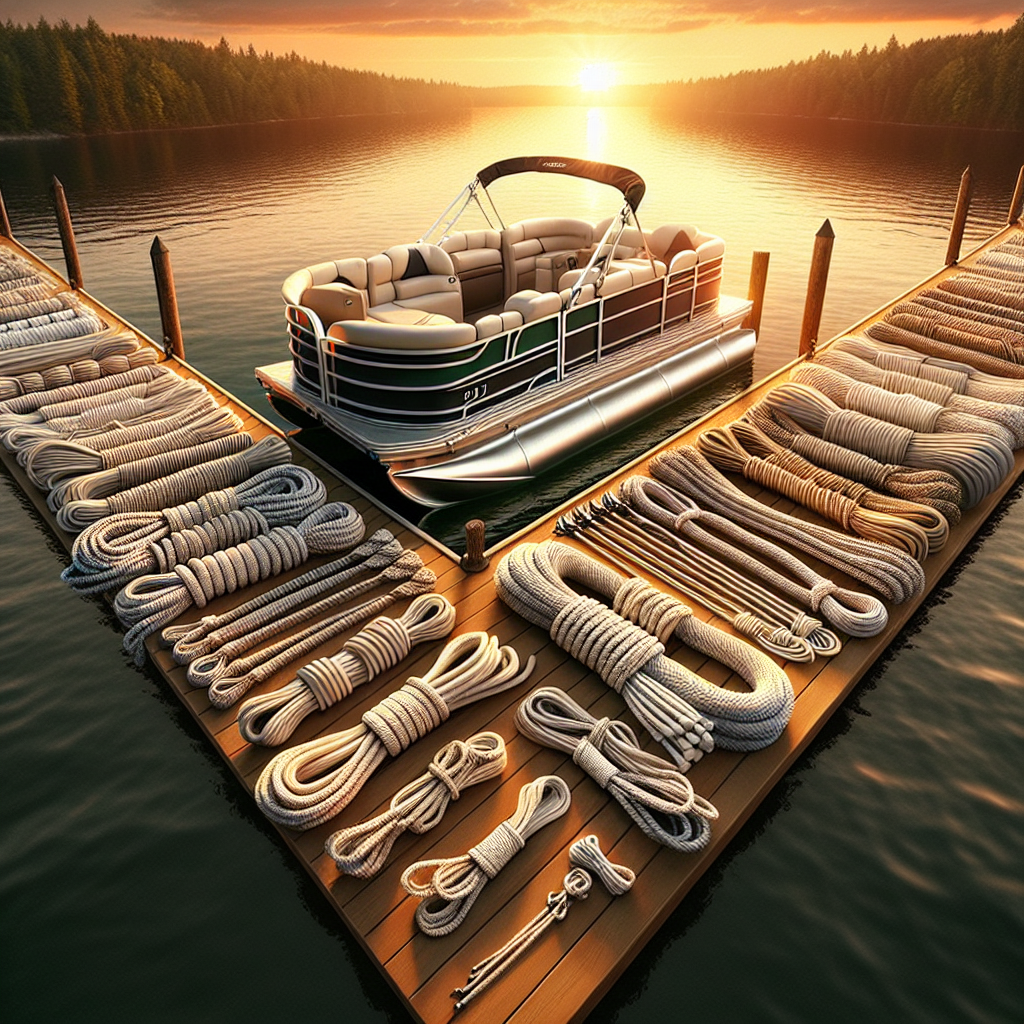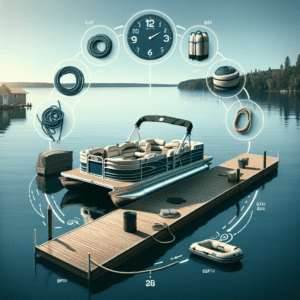Understanding Dock Lines for Pontoon Boats
Dock lines are an essential component of any boating experience, ensuring the safety and security of your vessel throughout your journey.
A. Importance of Selecting the Proper Dock Line
Choosing the right dock line for your pontoon boat is crucial in guaranteeing its safety and longevity. Dock lines act as a barrier between your boat and the dock, absorbing shock and preventing damage to your boat’s structure. The wrong dock line can potentially lead to costly repairs, injuries, or even loss of the boat.
B. Different Types of Dock Lines and Materials
There are several types of dock lines available, including nylon, polyester, and polypropylene. Each type has distinct characteristics that make them suitable for varying weather and water conditions. It’s essential to understand the differences to determine which material is best-suited for your pontoon boat.
C. Standard Dock Line Thickness for Pontoon Boats
The thickness of a dock line is also a crucial factor in ensuring the safety of your pontoon boat. Different pontoon boat sizes require different thicknesses of dock lines, and it’s essential to have the appropriate size for your pontoon boat to avoid any damage or accidents.
D. The Role of Dock Line Length
The length of dock lines also plays a significant role in docking your pontoon boat. It’s important to have the correct length for your vessel, depending on your mooring location, water condition, and boat size.
E. Weather and Environmental Considerations
Weather conditions and environmental factors such as tide levels can affect dock line performance. Understanding these factors can help you select the best dock line, ensuring the safety and security of your pontoon boat while docked.
Assessing Your Pontoon Boat’s Dock Line Needs
Choosing the right dock lines for your pontoon boat is crucial in ensuring the safety and security of your vessel while docked. There are several factors to consider when assessing your pontoon boat’s dock line needs.
Weight and Size of Your Pontoon Boat
The weight and size of your pontoon boat are important considerations when selecting proper dock lines. Heavier boats require thicker, stronger lines to withstand the weight and prevent any accidents while moored. Additionally, longer boats require longer lines to ensure they can be securely tied down.
Mooring Conditions and Type of Waters
The type of waters and mooring conditions you encounter should be taken into account as well. Rough waters and strong currents require thicker and more durable lines, while calm waters may allow for thinner lines. Additionally, certain environments may require specific types of lines, such as saltwater-resistant lines for boats docked in saltwater environments.
Docking Frequency and Duration
The frequency and duration of your dockings should also be considered when selecting dock lines. Frequent docking may put more wear and tear on your lines, requiring more durable materials. Additionally, longer duration dockings may require thicker lines to withstand prolonged strain.
Analyzing Pontoon Boat Manufacturer Recommendations
Reviewing your pontoon boat manufacturer’s recommendations for dock line selection is essential. They will often have specific recommendations for the weight, size, and environment of your vessel. It’s important to take these recommendations into consideration when selecting your dock lines to ensure proper safety and security.
A Guide to Choosing the Correct Dock Line Diameter
A. General Guidelines for Dock Line Diameter Based on Boat Length
Choosing the correct dock line diameter is crucial to ensure the safety of your pontoon boat. Dock lines that are too thick can be heavy and difficult to handle, while dock lines that are too thin may not be able to support the weight of your pontoon boat.
General guidelines suggest that dock lines should be 1/8 inch in diameter for every 9 feet of boat length. For example, if your pontoon boat is 24 feet long, you should consider using dock lines that are ⅜ inch in diameter.
It is important to keep in mind that these guidelines are just a starting point. Various other factors can impact the ideal dock line diameter for your pontoon boat.
B. Specific Diameter Recommendations for Pontoon Boats
When it comes to pontoon boats, it is recommended to use dock lines that are at least ½ inch in diameter. This diameter can provide the necessary support and strength required to keep your pontoon boat secured to the dock.
The weight of your pontoon boat should also be taken into consideration when choosing the diameter of your dock lines. Heavier pontoon boats may require dock lines that are thicker in diameter to provide adequate support.
Additionally, the type of water and mooring conditions can play a role in determining the ideal diameter of dock lines for your pontoon boat.
C. How to Measure Dock Line Diameter
If you are unsure about the diameter of your pontoon boat’s current dock lines or need to purchase new ones, measuring the diameter is a simple process. All you need is a caliper or ruler that has millimeter or inch measurements.
To measure the diameter of your dock line, gently lay the line flat and use the caliper or ruler to measure across the middle of the line. If the line is twisted or rotated, try unlaying it to get a more accurate measurement.
D. Comparing Nylon and Polyester Lines for Diameter and Stretch
Nylon and polyester are two of the most commonly used materials for dock lines. Each material offers unique advantages and disadvantages.
Nylon lines can stretch up to 40% of their original length, making them ideal for docking in areas with rough waters or high waves. Polyester, on the other hand, has very little stretch, making it better for calmer waters or shorter docking periods.
When it comes to choosing the diameter of your dock lines, keep in mind that nylon lines require thicker diameters to provide adequate support due to their stretchability. Polyester line diameters can be thinner because of their lack of give.
Determining the Optimal Length for Your Pontoon Boat’s Dock Lines
Dock lines are essential safety components for your pontoon boat. They play a vital role in keeping your vessel secured while moored, and therefore, you need to determine the appropriate length for each docking line.
A. Calculating Needed Length: Onboarding to Offboarding
The length of dock lines varies depending on the size of your pontoon boat and the water conditions. As such, you need to consider various factors to calculate the necessary length of dock lines.
You need to calculate the onboard and offboard length needed for each docking line. For onboard length, measure the distance from the boat’s attachment point to the rub rail. On the other hand, offboard length requires considering factors such as water level, tidal fluctuation, and wave action.
| Pontoon Length | Onboard Length Formula | Offboard Length Formula |
|---|---|---|
| 20 feet | 20+4=24 feet | 20×2+4=44 feet |
| 24 feet | 24+4=28 feet | 24×2+4=52 feet |
| 28 feet | 28+6=34 feet | 28×2+6=62 feet |
B. The Bowline, Stern Line, and Spring Line: How Much Length for Each?
After calculating the needed length, you need to distribute it among the different dock lines needed to secure the pontoon boat. The basic dock line setup consists of three types of lines: the bowline, stern line, and spring line.
The bowline secures the front part of the pontoon boat, while the stern line holds the rear part in place. The spring line attaches to the midship area and helps to adjust the boat’s position while preventing it from damage during winds or waves.
- The bowline should be 2/3 of the boat’s length plus 2 meters.
- The stern line should be the same length as the boat’s length.
- The spring line should be 1.5 times the boat’s length.
C. The Impact of Tide and Water Levels on Length Selection
Tidal fluctuations and changes in water levels have a significant impact on dock line length selection. The water level changes, and the tide can cause the boat to move closer or farther from the dock, exerting pressure on the dock line.
The boat’s weight and size can also influence the required dock line length. A bigger boat may need longer dock lines to provide adequate support, and heavier boats put more pressure on the lines.
D. Storage and Management of Excess Line
Once you’ve determined the appropriate length for each dock line, you need to manage the excess line. Cluttered or tangled dock lines can be hazardous and reduce their effectiveness. Secure the excess line on the boat using cleats or other storage options to avoid tripping hazards or entanglement of propellers.
Regular maintenance of the dock line length and storage improves their performance and longevity. Regularly inspect and replace old or worn-out dock lines to ensure the safety of the boat while docking.
| Pontoon Length | Onboard Length Formula | Offboard Length Formula |
|---|---|---|
| 20 feet | 20+4=24 feet | 20×2+4=44 feet |
| 24 feet | 24+4=28 feet | 24×2+4=52 feet |
| 28 feet | 28+6=34 feet | 28×2+6=62 feet |
| Type of Dock Line | Length Calculation | |
| Bowline | 2/3 of boat length + 2m | |
| Stern Line | Same length as boat length | |
| Spring Line | 1.5 times the boat’s length | |
Maintenance and Care Tips for Dock Lines
A. Regular Inspection and Replacement Schedules
Regular inspection and replacement schedules are critical to ensuring that your dock lines are in good working condition and can provide adequate support to your pontoon boat. It is essential to inspect your dock lines before each boating season for wear and tear, and replace any lines that are frayed or damaged. Additionally, you should regularly inspect your dock lines throughout the boating season, particularly after a severe storm, to ensure they remain in good condition.
B. Cleaning and Storage Best Practices
Cleaning and proper storage are also crucial to maintaining the life of your dock lines. Saltwater and other environmental factors can cause significant damage over time. So, it’s vital to rinse your dock lines with fresh water after each use to remove any salt, sand, or debris. Always store your dock lines in a safe, dry location that is protected from the elements.
C. Dealing with Abrasion and Wear
Abrasion and wear are common in dock lines, particularly in high-traffic areas. You can help minimize wear by using chafe gear or protective sleeves on your dock lines. If you notice any significant abrasion or wear, replace the line immediately.
D. Enhancing Dock Line Longevity with Chafe Protection
Chafe protection is an essential aspect of dock line care. Chafe gear or protective sleeves can help minimize abrasion and wear and extend the life of your dock lines. When choosing chafe protection, ensure you select material that is heavy-duty and can withstand the environment in which you’ll be operating your pontoon boat.
E. Troubleshooting Common Dock Line Issues
Common issues such as knotting, tangling, and twists can all be solved by proper selection, care, and maintenance of your dock lines. If you experience any issues with your dock lines, consult your manufacturer recommendations or a boating specialist for advice.
Frequently Asked Questions
Q: How often should I replace my dock lines?
A: It is a good idea to replace your dock lines at least every two years, or as soon as you notice any significant wear or damage.
Q: Can I use any dock line to secure my pontoon boat?
A: No, you cannot use any dock line, as not all dock lines are designed to handle the weight and size of a pontoon boat. It is essential to use the correct dock lines recommended by your pontoon boat manufacturer.
Q: Are all dock line materials the same?
A: No, dock lines can be made from a variety of materials, including nylon, polyester, and polypropylene. Each material has its unique advantages and disadvantages, and you should choose the material that best fits your docking situation and environment.







